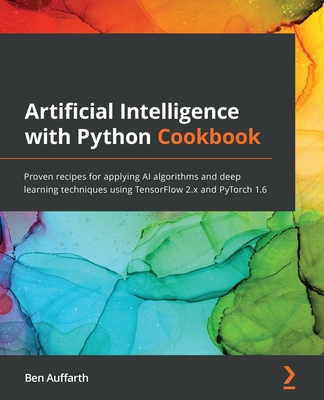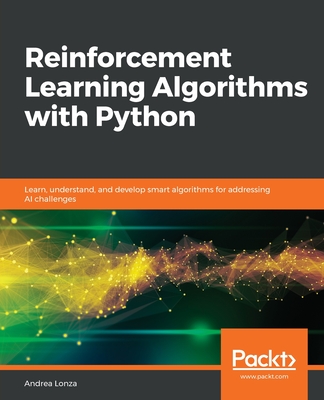Hands-On Genetic Algorithms with Python - Second Edition: Apply genetic algorithms to solve real-world AI and machine learning problems
暫譯: 實戰遺傳演算法與 Python - 第二版:應用遺傳演算法解決現實世界的 AI 和機器學習問題
Wirsansky, Eyal
- 出版商: Packt Publishing
- 出版日期: 2024-07-12
- 售價: $1,760
- 貴賓價: 9.5 折 $1,672
- 語言: 英文
- 頁數: 418
- 裝訂: Quality Paper - also called trade paper
- ISBN: 1805123793
- ISBN-13: 9781805123798
-
相關分類:
Machine Learning
立即出貨 (庫存=1)
相關主題
商品描述
Explore the ever-growing world of genetic algorithms to build and enhance AI applications involving search, optimization, machine learning, deep learning, NLP, and XAI using Python libraries
Key Features
- Learn how to implement genetic algorithms using Python libraries DEAP, scikit-learn, and NumPy
- Take advantage of cloud computing technology to increase the performance of your solutions
- Discover bio-inspired algorithms such as particle swarm optimization (PSO) and NEAT
- Purchase of the print or Kindle book includes a free PDF eBook
Book Description
Written by Eyal Wirsansky, a senior data scientist and AI researcher with over 25 years of experience and a research background in genetic algorithms and neural networks, Hands-On Genetic Algorithms with Python offers expert insights and practical knowledge to master genetic algorithms.
After an introduction to genetic algorithms and their principles of operation, you’ll find out how they differ from traditional algorithms and the types of problems they can solve, followed by applying them to search and optimization tasks such as planning, scheduling, gaming, and analytics. As you progress, you’ll delve into explainable AI and apply genetic algorithms to AI to improve machine learning and deep learning models, as well as tackle reinforcement learning and NLP tasks. This updated second edition further expands on applying genetic algorithms to NLP and XAI and speeding up genetic algorithms with concurrency and cloud computing. You’ll also get to grips with the NEAT algorithm. The book concludes with an image reconstruction project and other related technologies for future applications.
By the end of this book, you’ll have gained hands-on experience in applying genetic algorithms across a variety of fields, with emphasis on artificial intelligence with Python.
What you will learn
- Use genetic algorithms to solve planning, scheduling, gaming, and analytics problems
- Create reinforcement learning, NLP, and explainable AI applications
- Enhance the performance of ML models and optimize deep learning architecture
- Deploy genetic algorithms using client-server architectures, enhancing scalability and computational efficiency
- Explore how images can be reconstructed using a set of semi-transparent shapes
- Delve into topics like elitism, niching, and multiplicity in genetic solutions to enhance optimization strategies and solution diversity
Who this book is for
If you’re a data scientist, software developer, AI enthusiast who wants to break into the world of genetic algorithms and apply them to real-world, intelligent applications as quickly as possible, this book is for you. Working knowledge of the Python programming language is required to get started with this book.
商品描述(中文翻譯)
探索不斷擴展的遺傳演算法世界,以建立和增強涉及搜尋、優化、機器學習、深度學習、自然語言處理(NLP)和可解釋人工智慧(XAI)的 AI 應用,使用 Python 函式庫。
主要特點
- 學習如何使用 Python 函式庫 DEAP、scikit-learn 和 NumPy 實作遺傳演算法
- 利用雲端計算技術提升解決方案的效能
- 探索生物啟發的演算法,如粒子群優化(PSO)和 NEAT
- 購買印刷版或 Kindle 書籍可獲得免費 PDF 電子書
書籍描述
本書由 Eyal Wirsansky 撰寫,他是一位擁有超過 25 年經驗的資深數據科學家和 AI 研究員,並在遺傳演算法和神經網絡方面有研究背景。《Python 實作遺傳演算法》提供專家的見解和實用知識,幫助讀者掌握遺傳演算法。
在介紹遺傳演算法及其運作原理後,您將了解它們與傳統演算法的不同之處以及它們能解決的問題類型,接著將其應用於規劃、排程、遊戲和分析等搜尋和優化任務。隨著進展,您將深入探討可解釋的 AI,並將遺傳演算法應用於 AI,以改善機器學習和深度學習模型,並處理強化學習和 NLP 任務。本書的更新第二版進一步擴展了遺傳演算法在 NLP 和 XAI 中的應用,並透過併發和雲端計算加速遺傳演算法。您還將掌握 NEAT 演算法。本書以圖像重建專案和其他相關技術作為未來應用的結尾。
在本書結束時,您將獲得在各個領域應用遺傳演算法的實作經驗,重點在於使用 Python 的人工智慧。
您將學到的內容
- 使用遺傳演算法解決規劃、排程、遊戲和分析問題
- 創建強化學習、NLP 和可解釋的 AI 應用
- 提升機器學習模型的效能並優化深度學習架構
- 使用客戶端-伺服器架構部署遺傳演算法,增強可擴展性和計算效率
- 探索如何使用一組半透明形狀重建圖像
- 深入探討精英主義、利基和遺傳解決方案中的多樣性,以增強優化策略和解決方案的多樣性
本書適合對象
如果您是數據科學家、軟體開發人員或 AI 愛好者,想要快速進入遺傳演算法的世界並將其應用於現實的智能應用,這本書適合您。開始閱讀本書需要具備 Python 程式語言的工作知識。
目錄大綱
- An Introduction to Genetic Algorithms
- Understanding the Key Components of Genetic Algorithms
- Using the DEAP Framework
- Combinatorial Optimization
- Constraint Satisfaction
- Optimizing Continuous Functions
- Enhancing Machine Learning Models Using Feature Selection
- Hyperparameter Tuning Machine Learning Models
- Architecture Optimization of Deep Learning Networks
- Reinforcement Learning with Genetic Algorithms
- Natural Language Processing
- Explainable AI and Counterfactuals
- Speeding Up Genetic Algorithms with Concurrency
- Harnessing the Cloud
- Genetic Image Reconstruction
- Other Evolutionary and Bio-Inspired Computation Techniques
目錄大綱(中文翻譯)
- An Introduction to Genetic Algorithms
- Understanding the Key Components of Genetic Algorithms
- Using the DEAP Framework
- Combinatorial Optimization
- Constraint Satisfaction
- Optimizing Continuous Functions
- Enhancing Machine Learning Models Using Feature Selection
- Hyperparameter Tuning Machine Learning Models
- Architecture Optimization of Deep Learning Networks
- Reinforcement Learning with Genetic Algorithms
- Natural Language Processing
- Explainable AI and Counterfactuals
- Speeding Up Genetic Algorithms with Concurrency
- Harnessing the Cloud
- Genetic Image Reconstruction
- Other Evolutionary and Bio-Inspired Computation Techniques











